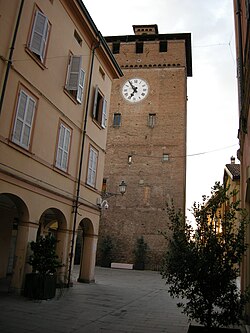Nonantola
Nonantola | |
|---|---|
 Modenesi tower in town centre | |
St. Sylvester | |
| Saint day | December 31 |
| Website | Official website |
Nonantola (
History
In ancient times the territory of Nonantola was inhabited by the Celtic tribes, more specifically by the
In the year 890 the town and the monastery were devastated by Hungarian marauders.
Nonantola was disputed between Modena and Bologna until it fell under Este's suzerainty (as an autonomous commune) in 1412. A constitution was issued in 1419. Nonantola remained a pacific agricultural centre well into the 17th century, when it had several urbanistic renovations.
In the Napoleonic Wars the abbey lost all its territories, which were acquired by the count Leonardo Salimbeni. In 1898 his palace, which once belonged to the monastery, was sold to the comune of Nonantola, becoming the Town Hall. In this age the agriculture started dying out, as the Modenese nobles used archaic methods of cultivation, and industries, trade and water were lacking.
During the German occupation in
Today Nonantola is an increasingly important cultural and tourist resort.

Abbey
Up to 1083 it was an imperial monastery, and its discipline often suffered severely on account of imperial interference in the election of abbots. In the beginning of the Conflict of Investitures it sided with the emperor, until forced to submit to the pope by Matilda of Canossa in 1083. It finally declared itself openly for the pope in 1111 when Placidus of Nonantola wrote his De honore Ecclesiæ,[3] a defence of the papal position during the Conflict of Investitures.
From the 13th century onwards the monastery decayed badly; the final decline began in 1419, when it came under the jurisdiction of commendatory abbots. In 1514 the abbey came into the possession of the
On 23 January 1821
Main sights
Nonantola contains several remains from the Middle Ages. These include the two towers called dei Modenesi and dei Bolognesi, and the Pieve of S. Michael Archangel (9th century).
The main monument, however, is the renowned abbey of San Sylvester Romanesque basilica, erected from the 8th century onwards. In the years 1913–17 it was restored to its original early 12th-century condition.[4]
References
- ^ "Superficie di Comuni Province e Regioni italiane al 9 ottobre 2011". Italian National Institute of Statistics. Retrieved 16 March 2019.
- ^ GeoDemo - Istat.it
- ^ Pez, Bernhard (1721). Thesaurus Anecdot. noviss., Volume II. Augsburg. pp. ii, 73 sq.
- ^ "La Basilica". Abbazia di Nonantola (in Italian). Retrieved 5 November 2013.


